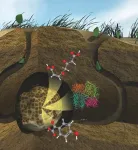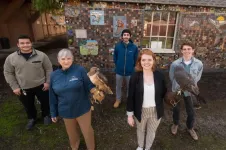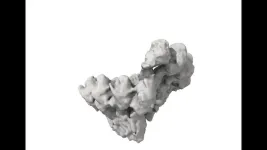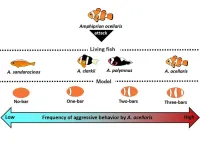(Press-News.org)
The São Paulo School of Advanced Science on Hologenomic Data Analysis for Agriculture (Hologenome School) will be held from July 29 to August 09, 2024, in São Carlos (São Paulo state, Brazil) at the EMBRAPA Southeastern Livestock, Embrapa Instrumentation, decentralized units of the Brazilian Agricultural Research Corporation (EMBRAPA), and at the University of São Paulo’s Chemistry Institute of São Carlos (IQSC-USP).
Hologenome School will provide students and young researchers with an interdisciplinary view of hologenomics and state-of-the-art knowledge on host-microbiome multi-omics data analyses and integration. The School aims to discuss how these tools could improve the development of new agricultural management strategies in order to improve food production and sustainability.
This 75-hour course will consist of lectures, practical classes on genomics, metagenomics and metabolomics data analysis, and technical visits to scientific institutions. Students participating in the School must be enrolled in undergraduate or postgraduate courses, in Brazil or abroad, being potential candidates for Master’s, Doctorate courses or internships as Post-Doctors researchers in higher education and research institutions in the State of São Paulo. Some young doctors may also be accepted.
The discussions at the School will greatly benefit from the participation of internationally renowned scientists as speakers, including Dr. Leluo Guan (The University of British Columbia, Canada), who will be speaking about “Omics-based nutrition to improve cattle production sustainability”; Haithem Afli (Munster Technological University, Ireland), a leading expert in Machine Learning and Natural Language Processing, who will be giving a lecture titled “The language of life”; Dr. Daniela Lourenco (University of Georgia, USA), a spokesperson for the single-step method that is most widely adopted for animal improvement, who will be expanding on “Modeling microbiome in genomic selection”, and others.
Approximately 40 applicants will be selected (20 Brazilian residents and 20 foreign residents); the participants will have the opportunity to present, in poster sessions, the results of their research, discussing the progress of their results with the participating scientists.
Additional applications from the general scientific community will be accepted for the first three days of plenary lectures.
Reporters are invited to register for the scientific sessions and short courses, which will present state-of-the-art science and the results of new research.
The São Paulo Research Foundation (FAPESP) is supporting the event through its São Paulo School of Advanced Science Program (SPSAS http://espca.fapesp.br/home). Students living outside São Paulo state can apply to receive financial support to cover the cost of air travel, accommodation, and meals.
Applications must be submitted by March 30, 2024.
END
Applications open for School of Hologenomic Data Analysis For Agriculture
The school will shed light on the latest advancements in multi-omics analyses and integration underlying the ultimate goal of improving food production and sustainability; submissions will be accepted until March 30, 2024.
2024-02-01
ELSE PRESS RELEASES FROM THIS DATE:
Insulin prices in US are nine times higher than in other wealthy nations, study finds
2024-02-01
The gross price of insulin in the U.S. is more than nine times higher than in 33 high-income comparison nations, according to a new RAND report.
Although the cost differences of insulin between the U.S. and other nations varied depending on the comparison country and the type of insulin, U.S. prices were always higher -- often five to 10 times higher -- than those in other countries. The new report updates findings from earlier RAND work about U.S. insulin prices.
After accounting for rebates and other discounts often offered by drug manufacturers, the price of a unit of insulin remained 2.3 times higher in the ...
Diabetes and liver cancer — Stanford Medicine study suggests new screening guidelines
2024-02-01
For centuries, doctors have used their hands as essential diagnostic tools — exploring joints and palpating abdomens to assess a patient’s health. Often a cancer will reveal itself as a lump or unusual stiffness in a normally bouncy tissue or organ.
More recently, the relationship between stiffness and cancer has been documented through biophysical studies and clinical trials, particularly in liver and breast cancer. For example, stiffness is a primary hallmark of liver cirrhosis, which can progress to liver cancer.
Now researchers ...
Researchers take new ‘mixed reality’ headsets for a spin
2024-02-01
Among the buzziest consumer technologies right now are “mixed reality” or “spatial computing” headsets that convincingly blend views of the real world with digital content.
A key enabling technology behind these gizmos is passthrough video, which involves blocking out all light so users must rely on cameras on the headsets to see the external world around them via real-time video playing on tiny screens. The arrangement allows users to physically interact with their environments and go about daily activities but with added digital content displayed, ranging from familiar device apps to innovative gaming scenarios. ...
How leafcutter ants cultivate a fungal garden to degrade plants and provide insights into future biofuels
2024-02-01
By Maegan Murray
Scientists have spent decades finding ways to efficiently and affordably degrade plant materials so that they can be converted into useful bioproducts that benefit everyday life.
Bio-based fuels, detergents, nutritional supplements, and even plastics are the result of this work. And while scientists have found ways to degrade plants to the extent needed to produce a range of products, certain polymers such as lignin, which is a primary ingredient in the cell wall of plants, remain incredibly difficult to affordably break down without adding pollutants back into the environment. These polymers can be left behind as waste products with ...
UC Davis establishes bird flight research center
2024-02-01
Researching how bird flight can inform aircraft design is the goal of a new center to be established at the University of California, Davis.
Christina Harvey, an assistant professor of mechanical and aerospace engineering at UC Davis, and Michelle Hawkins, a professor in the School of Veterinary Medicine and director of the California Raptor Center, are launching the bird flight research center with a nearly $3 million grant from the Department of Defense. The new center will utilize motion capture and photogrammetry ...
ADA releases updated recommendations to enhance radiography safety in dentistry
2024-02-01
CHICAGO, Feb. 1, 2024 – The use of lead abdominal aprons or thyroid collars on patients when conducting dental X-rays is no longer recommended, according to an expert panel established by the American Dental Association (ADA) Council on Scientific Affairs. Additionally, dentists should take into consideration the diagnostic information needed from X-rays to benefit patient care or substantially improve clinical outcomes.
The Journal of the American Dental Association published the new recommendations today, which aim to improve radiation ...
Cheating death: How cancer cells escape
2024-02-01
Cell death is fundamental to life and, thus, healthy aging. In the realm of cellular biology, ferroptosis (a form of programmed cell death) has emerged not only as a focal point of research for its potential in eliminating cancer cells, but also its role in a plethora of other diseases, including neurodegenerative diseases such as Alzheimer’s disease, eye diseases such as Retinitis pigmentosa and age-related macular degeneration, as well as ischemia, cardiovascular disease, liver disease, acute kidney injury and inflammation.
While studies of other forms of cell death such as apoptosis focus largely on ...
JMIR Medical Informatics invites submissions on AI language models in health care
2024-02-01
JMIR Publications is pleased to announce a new section titled, “AI Language Models in Health Care” in JMIR Medical Informatics. This leading peer-reviewed journal is indexed in PubMed and has a unique focus on clinical informatics and the digitization of care processes. This section will have a broad focus and encompass topics about the successful implementation of artificial intelligence (AI) language models in diverse health care settings. The topics will include details about the process, use, outcomes, and ...
Human cells building ‘molecular highways’ captured for first time
2024-02-01
Researchers at the Centre for Genomic Regulation (CRG) in Barcelona and the Spanish National Cancer Research Centre (CNIO) in Madrid have captured the world’s first high-resolution images of the earliest moments of microtubule formation inside human cells. The findings, published today in the journal Science, lay the foundations for potential breakthroughs in treating many different types of diseases ranging from cancer to neurodevelopmental disorders.
“Microtubules are critical components of cells, but all the images we see in textbooks describing the first moments of their creation are models or cartoons based ...
Clown anemonefish seem to be counting bars and laying down the law
2024-02-01
We often think of fish as carefree swimmers in the ocean, reacting to the world around them without much forethought. However, new research from the Okinawa Institute of Science and Technology (OIST) suggests that our marine cousins may be more cognizant than we credit them for.
By observing how a colony of clown anemonefish (Amphiprion ocellaris) – the species of the titular character in Finding Nemo – reacts to intruders in their sea anemone home, OIST researchers have found that ...
LAST 30 PRESS RELEASES:
New expert guidance urges caution before surgery for patients with treatment-resistant constipation
Solar hydrogen can now be produced efficiently without the scarce metal platinum
Sleeping in on weekends may help boost teens’ mental health
Study: Teens use cellphones for an hour a day at school
After more than two years of war, Palestinian children are hungry, denied education and “like the living dead”
The untold story of life with Prader-Willi syndrome - according to the siblings who live it
How the parasite that ‘gave up sex’ found more hosts – and why its victory won’t last
When is it time to jump? The boiling frog problem of AI use in physics education
Twitter data reveals partisan divide in understanding why pollen season's getting worse
AI is quick but risky for updating old software
Revolutionizing biosecurity: new multi-omics framework to transform invasive species management
From ancient herb to modern medicine: new review unveils the multi-targeted healing potential of Borago officinalis
Building a global scientific community: Biological Diversity Journal announces dual recruitment of Editorial Board and Youth Editorial Board members
Microbes that break down antibiotics help protect ecosystems under drug pollution
Smart biochar that remembers pollutants offers a new way to clean water and recycle biomass
Rice genes matter more than domestication in shaping plant microbiomes
Ticking time bomb: Some farmers report as many as 70 tick encounters over a 6-month period
Turning garden and crop waste into plastics
Scientists discover ‘platypus galaxies’ in the early universe
Seeing thyroid cancer in a new light: when AI meets label-free imaging in the operating room
Neutrophil-to-lymphocyte ratio may aid risk stratification in depressive disorder
2026 Seismological Society of America Annual Meeting
AI-powered ECG analysis offers promising path for early detection of chronic obstructive pulmonary disease, says Mount Sinai researchers
GIMM uncovers flaws in lab-grown heart cells and paves the way for improved treatments
Cracking the evolutionary code of sleep
Medications could help the aging brain cope with surgery, memory impairment
Back pain linked to worse sleep years later in men over 65, according to study
CDC urges ‘shared decision-making’ on some childhood vaccines; many unclear about what that means
New research finds that an ‘equal treatment’ approach to economic opportunity advertising can backfire
Researchers create shape-shifting, self-navigating microparticles
[Press-News.org] Applications open for School of Hologenomic Data Analysis For AgricultureThe school will shed light on the latest advancements in multi-omics analyses and integration underlying the ultimate goal of improving food production and sustainability; submissions will be accepted until March 30, 2024.



